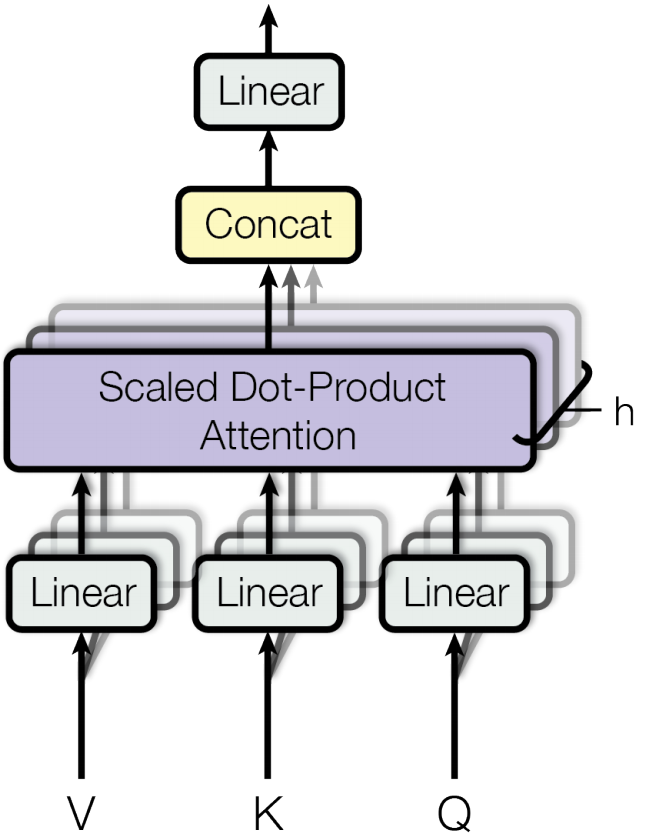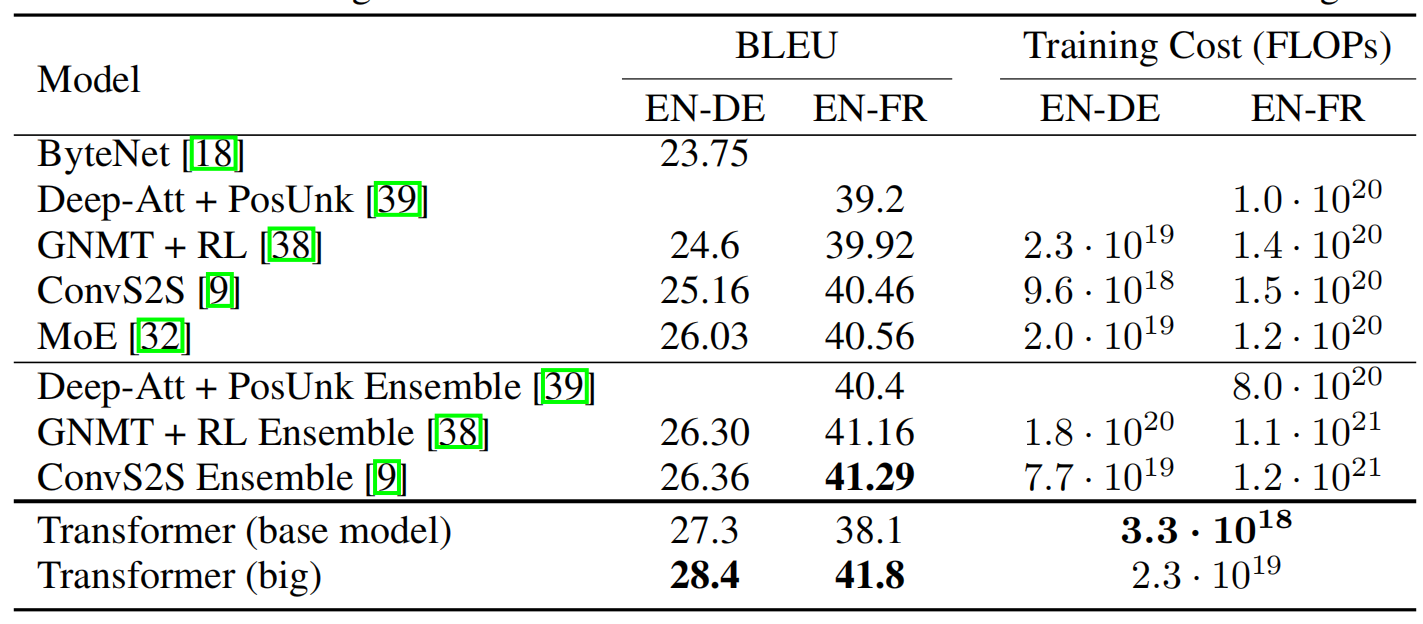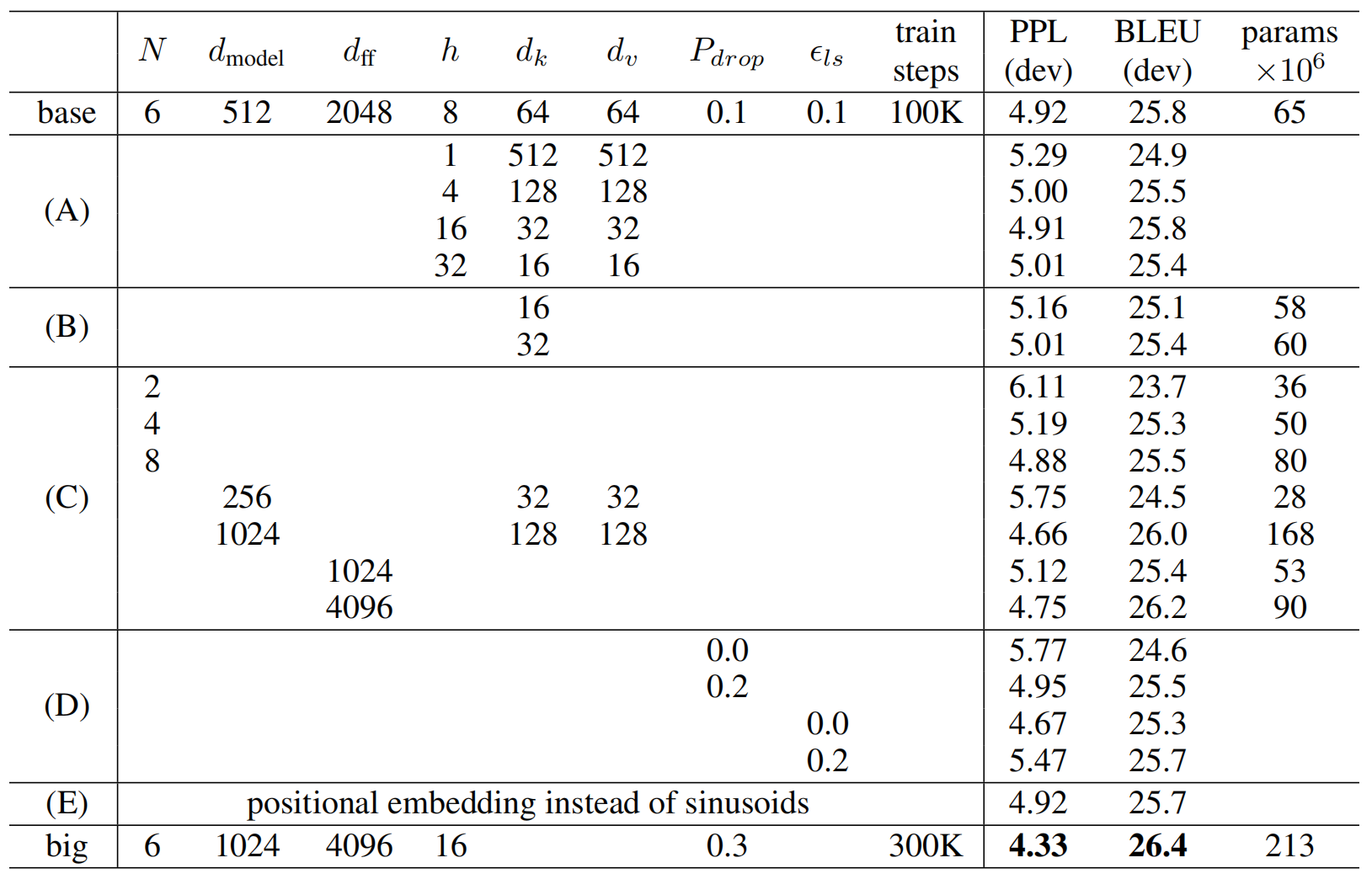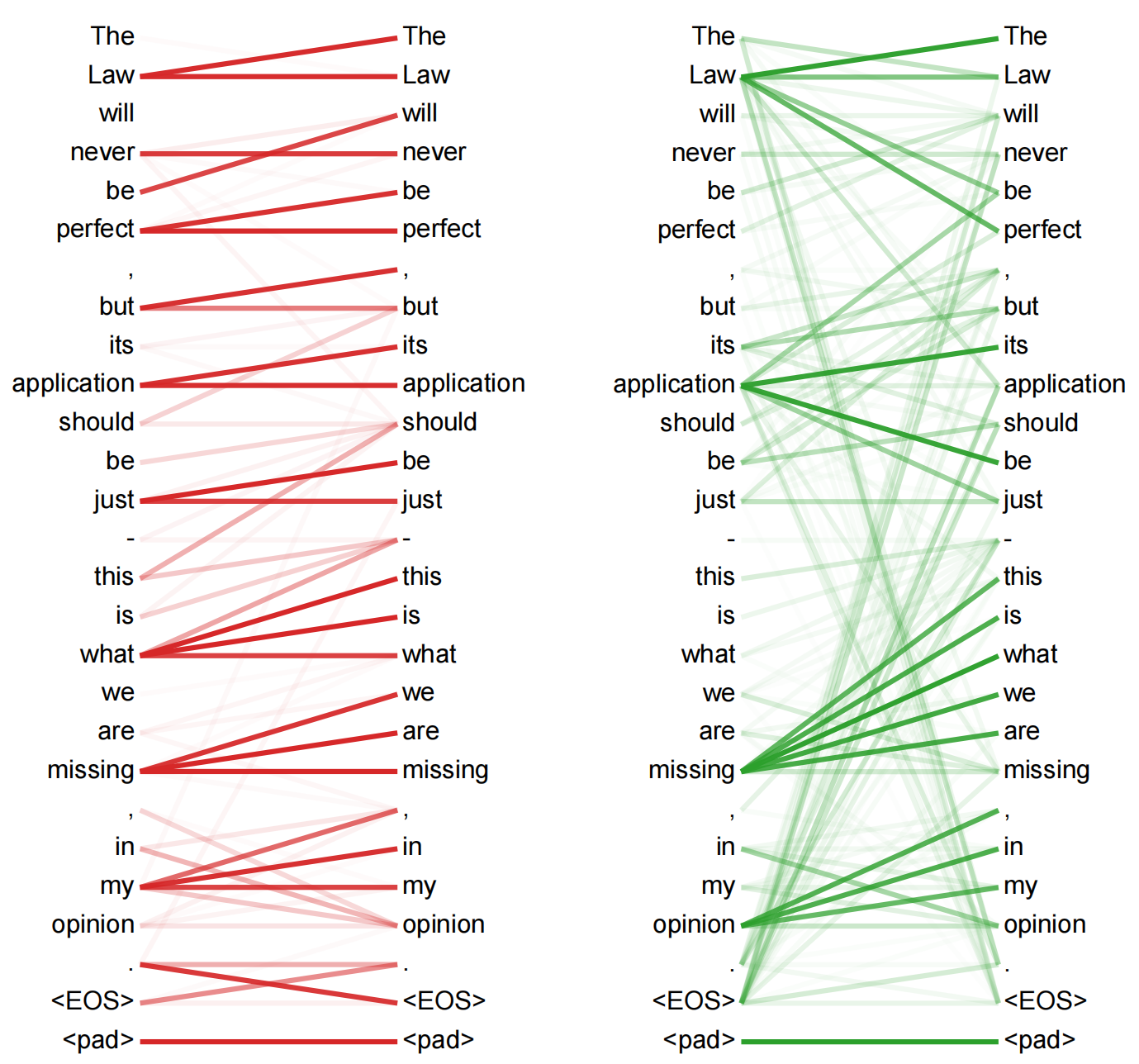【2017-12-06】Attention is all you need
0、背景
The dominant sequence transduction(转导; 换能,转换,变频)models are based on complex recurrent or convolutional neural networks that include an encoder and a decoder.
- Recurrent neural networks,long short-term memory and gated recurrent neural networks in particular, have been firmly established as state of the art approaches in sequence modeling and transduction problems such as language modeling and machine translation.
- Numerous efforts have since continued to push the boundaries of recurrent language models and encoder-decoder architectures.
- Recurrent models typically factor computation along the symbol positions of the input and output sequences. Aligning the positions to steps in computation time, they generate a sequence of hidden states
, as a function of the previous hidden state
and the input for position
. This inherently sequential nature precludes(preclude 排除; 妨碍; 阻止; 使…行不通)parallelization within training examples, which becomes critical at longer sequence lengths, as memory constraints limit batching across examples.
- Recent work has achieved signifificant improvements in computational effificiency through factorization(因式分解)tricks and conditional computation, while also improving model performance in case of the latter.
- factorization tricks:【2018-02-24】Factorization tricks for LSTM networks
- conditional computation:【2017-00-00】Outrageously Large Neural Networks:The Sparsely-Gated Mixture-of-Experts Layer
- The fundamental constraint of sequential computation, however, remains.
- Recent work has achieved signifificant improvements in computational effificiency through factorization(因式分解)tricks and conditional computation, while also improving model performance in case of the latter.
- The best performing models also connect the encoder and decoder through an attention mechanism.
- Attention mechanisms have become an integral part of compelling sequence modeling and transduction models in various tasks, allowing modeling of dependencies without regard to their distance in the input or output sequences. In all but a few cases, however, such attention mechanisms are used in conjunction with a recurrent network.
- The goal of reducing sequential computation also forms the foundation of the Extended Neural GPU, ByteNet and ConvS2S, all of which use convolutional neural networks as basic building block, computing hidden representations in parallel for all input and output positions.
- In these models, the number of operations required to relate signals from two arbitrary input or output positions grows in the distance between positions, linearly for ConvS2S and logarithmically for ByteNet. This makes it more diffificult to learn dependencies between distant positions(参考:【2001-00-00】Gradient Flow in Recurrent Nets:the Difficulty of Learning Long-Term Dependencies)。
- In the Transformer this is reduced to a constant number of operations, albeit at the cost of reduced effective resolution due to averaging attention-weighted positions, an effect we counteract(抵制; 抵消; 抵抗)with Multi-Head Attention.
- Extended Neural GPU:【2017-03-07】Can Active Memory Replace Attention?
- ByteNet:【2017-03-15】Neural Machine Translation in Linear Time
- ConvS2S:【2017-07-25】Convolutional Sequence to Sequence Learning
- Self-attention, sometimes called intra-attention is an attention mechanism relating different positions of a single sequence in order to compute a representation of the sequence. Self-attention has been used successfully in a variety of tasks including reading comprehension, abstractive summarization, textual entailment and learning task-independent sentence representations.
- 【2016-09-20】Long Short-Term Memory-Networks for Machine Reading
- 【2017-03-09】A structured self-attentive sentence embedding
- 【2016-09-25】A Decomposable Attention Model for Natural Language Inference
- 【2017-11-13】A deep reinforced model for abstractive summerization
End-to-end memory networks are based on a recurrent attention mechanism instead of sequence-aligned recurrence and have been shown to perform well on simple-language question answering and language modeling tasks.
We propose a new simple network architecture(Transformer)based solely on attention mechanisms, dispensing with recurrence and convolutions entirely.
- Transformer,a model architecture eschewing recurrence and instead relying entirely on an attention mechanism to draw global dependencies between input and output.
- The Transformer allows for signifificantly more parallelization and can reach a new state of the art in translation quality after being trained for as little as twelve hours on eight P100 GPUs.
- Transformer is the first transduction model relying entirely on self-attention to compute representations of its input and output without using sequence-aligned RNNs or convolution.
- Most competitive neural sequence transduction models have an encoder-decoder structure. Here, the encoder maps an input sequence of symbol representations
to a sequence of continuous representations
. Given
, the decoder then generates an output sequence
of symbols one element at a time. At each step the model is auto-regressive, consuming the previously generated symbols as additional input when generating the next.
- The Transformer follows this overall architecture using stacked self-attention and point-wise, fully connected layers for both the encoder and decoder, shown in the left and right halves of Figure 1, respectively.
(1)Encoder and Decoder Stacks
(a)Encoder:
- The encoder is composed of a stack of
identical layers. Each layer has two sub-layers.
- The first is a multi-head self-attention mechanism
- The second is a simple, position-wise fully connected feed-forward network.
We employ a residual connection around each of the two sub-layers, followed by layer normalization.
- That is, the output of each sub-layer is
, where
is the function implemented by the sub-layer itself.
- To facilitate these residual connections, all sub-layers in the model, as well as the embedding layers, produce outputs of dimension
.
- That is, the output of each sub-layer is
The decoder is also composed of a stack of
identical layers.
- In addition to the two sub-layers in each encoder layer, the decoder inserts a third sub-layer, which performs multi-head attention over the output of the encoder stack.
Similar to the encoder, we employ residual connections around each of the sub-layers, followed by layer normalization. We also modify the self-attention sub-layer in the decoder stack to prevent positions from attending to subsequent positions. This masking, combined with fact that the output embeddings are offset by one position, ensures that the predictions for position
can depend only on the known outputs at positions less than
.
(2)Attention
An attention function can be described as mapping a query and a set of key-value pairs to an output, where the query, keys, values, and output are all vectors.
The input consists of:
- queries
- keys of dimension
- values of dimension
.
- We compute the dot products of the query with all keys, divide each by
, and apply a softmax function to obtain the weights on the values.
- In practice, we compute the attention function on a set of queries simultaneously, packed together into a matrix
. The keys and values are also packed together into matrices
and
. We compute the matrix of outputs as:
- The two most commonly used attention functions are additive attention, and dot-product (multiplicative) attention.
- Dot-product attention is identical to our algorithm, except for the scaling factor of
.
- Additive attention computes the compatibility function using a feed-forward network with a single hidden layer.
- 参考:【2016-05-19】Neural machine translation by jointly learning to align and translate
- Dot-product attention is identical to our algorithm, except for the scaling factor of
- While the two are similar in theoretical complexity, dot-product attention is much faster and more space-efficient in practice, since it can be implemented using highly optimized matrix multiplication code.
While for small values of
the two mechanisms perform similarly, additive attention outperforms dot product attention without scaling for larger values of
(参考:【2017-03-21】Massive exploration of neural machine translation architectures).
- We suspect that for large values of
, the dot products grow large in magnitude, pushing the softmax function into regions where it has extremely small gradients . To counteract this effect, we scale the dot products by
.
- To illustrate why the dot products get large, assume that the components of
and
are independent random variables with mean 0 and variance 1. Then their dot product,
, has mean 0 and variance
.
(b)Multi-Head Attention

- We suspect that for large values of
Instead of performing a single attention function with
-dimensional keys, values and queries, we found it benefificial to linearly project the queries, keys and values
times with different, learned linear projections to
,
and
dimensions, respectively. On each of these projected versions of queries, keys and values we then perform the attention function in parallel, yielding
-dimensional output values. These are concatenated and once again projected, resulting in the final values.
- Multi-head attention allows the model to jointly attend to information from different representation subspaces at different positions. With a single attention head, averaging inhibits this.
- we employ
parallel attention layers, or heads. For each of these we use
. Due to the reduced dimension of each head, the total computational cost is similar to that of single-head attention with full dimensionality.
The Transformer uses multi-head attention in three different ways:
- In “encoder-decoder attention” layers, the queries come from the previous decoder layer, and the memory keys and values come from the output of the encoder.
- This allows every position in the decoder to attend over all positions in the input sequence. This mimics the typical encoder-decoder attention mechanisms in sequence-to-sequence models(参考如下论文).
- 【2016-05-19】Neural machine translation by jointly learning to align and translate
- 【2016-10-08】Google’s neural machine translation system:Bridging the gap between human and machine translation
- 【2017-07-25】Convolutional Sequence to Sequence Learning
- This allows every position in the decoder to attend over all positions in the input sequence. This mimics the typical encoder-decoder attention mechanisms in sequence-to-sequence models(参考如下论文).
- The encoder contains self-attention layers. In a self-attention layer all of the keys, values and queries come from the same place, in this case, the output of the previous layer in the encoder. Each position in the encoder can attend to all positions in the previous layer of the encoder.
- Similarly, self-attention layers in the decoder allow each position in the decoder to attend to all positions in the decoder up to and including that position. We need to prevent leftward information flow in the decoder to preserve the auto-regressive property. We implement this inside of scaled dot-product attention by masking out (setting to
) all values in the input of the softmax which correspond to illegal connections.
(c)Why self-attention
- In “encoder-decoder attention” layers, the queries come from the previous decoder layer, and the memory keys and values come from the output of the encoder.
we compare various aspects of self-attention layers to the recurrent and convolutional layers commonly used for mapping one variable-length sequence of symbol representations
to another sequence of equal length
, with
, such as a hidden layer in a typical sequence transduction encoder or decoder.
- Motivating our use of self-attention we consider three desiderata(desideratum [dɪˌzɪdəˈrɑːtəm] n. 想望的东西; 需要的东西; 复数形式:desiderata).
- Total computational complexity per layer
- The amount of computation that can be parallelized(measured by the minimum number of sequential operations required)
- The path length between long-range dependencies in the network
- Learning long-range dependencies is a key challenge in many sequence transduction tasks. One key factor affecting the ability to learn such dependencies is the length of the paths forward and backward signals have to traverse([trəˈvɜ:rs] 通过; 横越,横贯; [法] 否认,反驳; [木工] 横刨)in the network. The shorter these paths between any combination of positions in the input and output sequences, the easier it is to learn long-range dependencies(参考:【2001-00-00】Gradient Flow in Recurrent Nets:the Difficulty of Learning Long-Term Dependencies).
- Hence we also compare the maximum path length between any two input and output positions in networks composed of the different layer types(shown below:Maximum path lengths, per-layer complexity and minimum number of sequential operations for different layer types).
:the sequence length
:the representation dimension
:the kernel size of convolutions
:the size of the neighborhood in restricted self-attention

- 结论:
- sequential operations:
- self-attention layer connects all positions with a constant number of sequentially executed operations
- recurrent layer requires
sequential operations
- computational complexity
- self-attention layers are faster than recurrent layers when the sequence length
is smaller than the representation dimensionality
, which is most often the case with sentence representations used by state-of-the-art models in machine translations, such as word-piece and byte-pair representations.
- word-piece:【2016-10-08】Google’s neural machine translation system:Bridging the gap between human and machine translation
- byte-pair:【2016-06-10】Neural machine translation of rare words with subword units
- self-attention layers are faster than recurrent layers when the sequence length
- To improve computational performance for tasks involving very long sequences, self-attention could be restricted to considering only a neighborhood of size
in the input sequence centered around the respective output position. This would increase the maximum path length to
.
- A single convolutional layer with kernel width
does not connect all pairs of input and output positions. Doing so requires a stack of
convolutional layers in the case of contiguous kernels, or
in the case of dilated(dilate [daɪˈlet,ˈdaɪˌlet] 扩张; 详述; 使扩大; 使膨胀)convolutions(参考:【2017-03-15】Neural Machine Translation in Linear Time), increasing the length of the longest paths between any two positions in the network. Convolutional layers are generally more expensive than recurrent layers, by a factor of
. Separable convolutions(【2017-04-04】Xception:Deep learning with depthwise separable convolutions), however, decrease the complexity considerably, to
. Even with
, however, the complexity of a separable convolution is equal to the combination of a self-attention layer and a point-wise feed-forward layer, the approach we take in our model.
As side benefit(附带利益), self-attention could yield more interpretable(可说明的;可判断的;可翻译的)models. We inspect attention distributions from our models and present and discuss examples in the appendix. Not only do individual attention heads clearly learn to perform different tasks, many appear to exhibit behavior related to the syntactic and semantic structure of the sentences.
(3)Position-wise Feed-Forward Networks
In addition to attention sub-layers, each of the layers in our encoder and decoder contains a fully connected feed-forward network, which is applied to each position separately and identically. This consists of two linear transformations with a ReLU activation in between.
- While the linear transformations are the same across different positions, they use different parameters from layer to layer. Another way of describing this is as two convolutions with kernel size 1.
The dimensionality of input and output is
, and the inner-layer has dimensionality
.
(4)Embeddings and Softmax
Similarly to other sequence transduction models, we use learned embeddings to convert the input tokens and output tokens to vectors of dimension
. We also use the usual learned linear transformation and softmax function to convert the decoder output to predicted next-token probabilities.
In our model, we share the same weight matrix between the two embedding layers and the pre-softmax linear transformation(类似:【2017-02-21】Using the output embedding to improve language models).
Since our model contains no recurrence and no convolution, in order for the model to make use of the order of the sequence, we must inject some information about the relative or absolute position of the tokens in the sequence.
- To this end, we add “positional encodings” to the input embeddings at the bottoms of the encoder and decoder stacks. The positional encodings have the same dimension
as the embeddings, so that the two can be summed.
- There are many choices of positional encodings, learned and fixed(参考:【2017-07-25】Convolutional Sequence to Sequence Learning), In this work, we use sine and cosine functions of different frequencies:
:position
:dimension
- That is, each dimension of the positional encoding corresponds to a sinusoid([‘saɪnəˌsɔɪd] 正弦波; 正弦曲线; 正弦形). The wavelengths(波长; (广播电台等占用的) 频道,波道;)form a geometric progression from
to
.
- We chose this function because we hypothesized it would allow the model to easily learn to attend by relative positions, since for any fixed offset
,
can be represented as a linear function of
.
We also experimented with using learned positional embeddings instead, and found that the two versions produced nearly identical results. We chose the sinusoidal version because it may allow the model to extrapolate([ɪkˈstræpəˌlet] (由已知资料对未知事实或价值) 推算,推断)to sequence lengths longer than the ones encountered during training.
2、模型训练
Training Data and Batching
- We trained on the standard WMT 2014 English-German dataset consisting of about 4.5 million sentence pairs. Sentences were encoded using byte-pair encoding(【2017-03-21】Massive exploration of neural machine translation architectures), which has a shared source-target vocabulary of about 37000 tokens.
- For English-French, we used the signifificantly larger WMT 2014 English-French dataset consisting of 36M sentences and split tokens into a 32000 word-piece vocabulary. Sentence pairs were batched together by approximate sequence length. Each training batch contained a set of sentence pairs containing approximately 25000 source tokens and 25000 target tokens.
- Hardware and Schedule
- We trained our models on one machine with 8 NVIDIA P100 GPUs. For our base models using the hyperparameters described throughout the paper, each training step took about 0.4 seconds. We trained the base models for a total of 100,000 steps or 12 hours. For our big models, step time was 1.0 seconds. The big models were trained for 300,000 steps(3.5 days).
- Optimizer
- We used the Adam optimizer(【2017-01-30】Adam:A method for stochastic optimization)with
,
and
. We varied the learning rate over the course of training, according to the formula:
- This corresponds to increasing the learning rate linearly for the first
training steps, and decreasing it thereafter proportionally to the inverse square root of the step number. We used
.
- We used the Adam optimizer(【2017-01-30】Adam:A method for stochastic optimization)with
Regularization
- We employ three types of regularization during training:
- Residual Dropout
- We apply dropout to the output of each sub-layer, before it is added to the sub-layer input and normalized.
- dropout:【2014-06-00】Dropout:A Simple Way to Prevent Neural Networks from Overfitting
- In addition, we apply dropout to the sums of the embeddings and the positional encodings in both the encoder and decoder stacks. For the base model, we use a rate of
- We apply dropout to the output of each sub-layer, before it is added to the sub-layer input and normalized.
- Label Smoothing
评测任务:WMT 2014 translation task(模型结果在newstest2014 tests 的相应语言对上进行评估)
- Experiments on two machine translation tasks show these models to be superior in quality while being more parallelizable and requiring signifificantly less time to train.
- Achieves 28.4 BLEU on the WMT 2014 English-to-German(EN-DE)translation task, improving over the existing best results(including ensembles)by over 2 BLEU.
- On the WMT 2014 English-to-French(EN-FR)translation task, our model establishes a new single-model state-of-the-art BLEU score of 41.8 after training for 3.5 days on eight GPUs, a small fraction of the training costs of the best models from the literature.

- ByteNet:【2017-03-15】Neural Machine Translation in Linear Time
- Deep-Att + PosUnk 和 Deep-Att + PosUnk Ensemble:【2016-07-23】Deep recurrent models with fast-forward connections for neural machine translation
- GNMT + RL 和 GNMT + RL Ensemble:【2016-10-08】Google’s neural machine translation system:Bridging the gap between human and machine translation
- ConvS2S 和 ConvS2S Ensemble:【2017-07-25】Convolutional Sequence to Sequence Learning
- MoE:【2017-00-00】Outrageously Large Neural Networks:The Sparsely-Gated Mixture-of-Experts Layer
- 说明:
- The Transformer (big) model trained for English-to-French used dropout rate
, instead of 0_._3.
- For the base models, we used a single model obtained by averaging the last 5 checkpoints, which were written at 10-minute intervals.
- For the big models, we averaged the last 20 checkpoints. We used beam search with a beam size of 4 and length penalty
. These hyperparameters were chosen after experimentation on the development set. We set the maximum output length during inference to input length +50, but terminate early when possible.
- 参考:【2016-10-08】Google’s neural machine translation system:Bridging the gap between human and machine translation
- We estimate the number of floating point operations used to train a model by multiplying the training time, the number of GPUs used, and an estimate of the sustained single-precision floating-point capacity of each GPU.
- Unlisted values are identical to those of the base model. All metrics are on the English-to-German translation development set, newstest2013. Listed perplexities are per-wordpiece, according to our byte-pair encoding, and should not be compared to per-word perplexities.
- We used beam search, but no checkpoint averaging.

- (A):we vary the number of attention heads and the attention key and value dimensions, keeping the amount of computation constant. While single-head attention is 0.9 BLEU worse than the best setting, quality also drops off with too many heads.
- (B):we observe that reducing the attention key size
hurts model quality. This suggests that determining compatibility is not easy and that a more sophisticated compatibility function than dot product may be benefificial.
- (C) and (D):as expected, bigger models are better, and dropout is very helpful in avoiding over-fifitting.
(E):we replace our sinusoidal positional encoding with learned positional embeddings(【2017-07-25】Convolutional Sequence to Sequence Learning), and observe nearly identical results to the base model.
(3)English Constituency Parsing 结果
To evaluate if the Transformer can generalize to other tasks we performed experiments on English constituency parsing. This task presents specific challenges:
- The output is subject to strong structural constraints and is significantly longer than the input.
- Furthermore, RNN sequence-to-sequence models have not been able to attain state-of-the-art results in small-data regimes.
- We show that the Transformer generalizes well to other tasks by applying it successfully to English constituency parsing both with large and limited training data.
- The Transformer generalizes well to English constituency parsing (Results are on Section 23 of WSJ):

- We trained a 4-layer transformer with
on the Wall Street Journal (WSJ) portion of the Penn Treebank(【1993-00-00】Building a large annotated corpus of english:The penn treebank), about 40K training sentences. We also trained it in a semi-supervised setting, using the larger high-confidence and BerkleyParser corpora from with approximately 17M sentences (【2015-06-09】Grammar as a foreign language). We used a vocabulary of 16K tokens for the WSJ only setting and a vocabulary of 32K tokens for the semi-supervised setting.
- During inference, we increased the maximum output length to input length +300. We used a beam size of 21 and
for both WSJ only and the semi-supervised setting.
- Results in Table show that despite the lack of task-specific tuning our model performs surprisingly well, yielding better results than all previously reported models with the exception of the Recurrent Neural Network Grammar(【2016-10-12】Recurrent neural network grammars).
In contrast to RNN sequence-to-sequence models(【2015-06-09】Grammar as a foreign language), the Transformer outperforms the BerkeleyParser(【2006-00-00】Learning accurate,compac,and Interpretable Tree Annotation)even when training only on the WSJ training set of 40K sentences.
4、展望
We are excited about the future of attention-based models and plan to apply them to other tasks. We plan to extend the Transformer to problems involving input and output modalities other than text and to investigate local, restricted attention mechanisms to efficiently handle large inputs and outputs such as images, audio and video. Making generation less sequential is another research goals of ours.
The code we used to train and evaluate our models is available at:
- https://github.com/tensorflow/tensor2tensor
5、Appendix:Attention Visualization
- https://github.com/tensorflow/tensor2tensor
An example of the attention mechanism following long-distance dependencies in the encoder self-attention in layer 5 of 6. Many of the attention heads attend to(注意; 处理; 听取; 致力于)a distant dependency of the verb ‘making’, completing the phrase ‘making…more diffificult’. Attentions here shown only for the word ‘making’. Different colors represent different heads. Best viewed in color.

- Two attention heads, also in layer 5 of 6, apparently involved in anaphora resolution(指代消解; 指代消解问题; 回指释义; 回指解析; 同指消解 anaphora [əˈnæfərə] 逆向照应,复指(下文的词返指或代替上文的词)). Top: Full attentions for head 5. Bottom: Isolated attentions from just the word ‘its’ for attention heads 5 and 6. Note that the attentions are very sharp for this word.

- Many of the attention heads exhibit behaviour that seems related to the structure of the sentence. We give two such examples above, from two different heads from the encoder self-attention at layer 5 of 6. The heads clearly learned to perform different tasks.




